Henri Vieuxtemps, born in Verviers, Belgium, on February 17, 1820, was a prodigious talent who would go on to become one of the most influential violinists and composers of the Romantic era. From a young age, Vieuxtemps displayed an extraordinary aptitude for the violin, giving his first public performance at the tender age of six. His father, a weaver and amateur violinist, recognized his son’s exceptional gift and devoted himself to nurturing Henri’s talent.
As a child, Vieuxtemps studied under Charles de Bériot, a renowned Belgian violinist, who helped shape the young prodigy’s technique and musical sensibilities. By the age of seven, Vieuxtemps was already embarking on concert tours, captivating audiences across Europe with his remarkable skill and emotive performances. His early success led him to Paris, where he continued his studies and began to make a name for himself in the competitive world of classical music.
Vieuxtemps’ career as a virtuoso violinist took him across Europe and to the United States, where he dazzled audiences with his technical prowess and expressive playing. His performances were characterized by a rich, singing tone and a remarkable ability to convey deep emotion through his instrument. Vieuxtemps’ style was emblematic of the Romantic period, emphasizing personal expression and emotional intensity.
As a composer, Vieuxtemps made significant contributions to the violin repertoire. His seven violin concertos are particularly noteworthy, with the Fourth and Fifth Concertos still being regularly performed and studied by violinists today. These works showcased not only his understanding of the instrument’s capabilities but also his gift for melody and his ability to blend virtuosic passages with lyrical themes.
Vieuxtemps’ compositions went beyond concertos, encompassing chamber music, orchestral works, and pieces for solo violin. His output included sonatas, études, caprices, and fantasias, many of which remain important parts of the violin literature. His works were innovative for their time, expanding the technical and expressive possibilities of the violin while maintaining a strong sense of musical structure and coherence.
In addition to his performing and composing career, Vieuxtemps was also a dedicated teacher. He held a prestigious position at the Brussels Conservatory and later taught at the St. Petersburg Conservatory in Russia. His pedagogical influence was far-reaching, and he played a crucial role in developing what became known as the Franco-Belgian school of violin playing. This school emphasized a combination of technical precision and expressive interpretation, qualities that Vieuxtemps himself exemplified in his performances and compositions.
Vieuxtemps’ life was not without challenges. In 1873, he suffered a stroke that partially paralyzed his right arm, effectively ending his career as a performer. However, this setback did not diminish his passion for music. He continued to compose and teach, channeling his artistic energy into these pursuits until his death on June 6, 1881, in Mustapha Supérieur, Algeria, where he had retreated for health reasons.
The legacy of Henri Vieuxtemps extends far beyond his lifetime. His innovative approach to violin technique and composition influenced generations of violinists and composers. His works continue to be performed and recorded by leading musicians, and his pedagogical principles remain relevant in violin instruction today. Vieuxtemps’ life and career embody the spirit of the Romantic era in classical music – a time of great expression, technical innovation, and the elevation of the virtuoso performer to near-mythical status.
Henri Vieuxtemps’ contributions to the world of music were multifaceted and enduring. As a performer, he set new standards for violin playing; as a composer, he expanded the instrument’s repertoire with works of lasting value; and as a teacher, he shaped the future of violin pedagogy. His life story is a testament to the power of musical talent nurtured from an early age and the impact that a single, devoted artist can have on an entire musical tradition.


